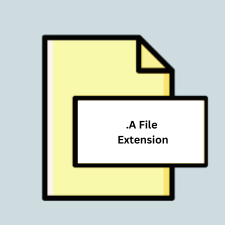.A File Extension

Static Library
| Developer | N/A |
| Popularity | |
| Category | Developer Files |
| Format | .A |
| Cross Platform | Update Soon |
What is an A file?
Files with the .a extension are static library files commonly used in Unix-like operating systems, including Linux and macOS. These files contain a collection of compiled object code, which can be linked into programs during the build process. Static libraries are used to provide reusable functions or routines that can be included in multiple programs.
More Information.
Static libraries were introduced to allow developers to share code efficiently across different programs without needing to include the source code directly in each application. This practice reduces code duplication, simplifies maintenance, and promotes modular programming. The .a file format has been used since the early days of Unix systems and has become a standard way to distribute pre-compiled code libraries.
Origin Of This File.
The .a file extension stands for “archive” and originates from the Unix ar (archiver) utility, which is used to create, modify, and extract from archives. The ar utility was developed in the early days of Unix, around the 1970s, to bundle multiple files into a single file, making it easier to distribute and manage libraries of code.
File Structure Technical Specification.
A .a file is essentially an archive of object files (.o files). Each object file within the archive contains machine code, symbol tables, and other necessary metadata.
The structure of a .a file typically includes:
- Archive Header: Contains metadata about the archive, such as the file format version and other control information.
- File Headers: Each object file has a header that contains metadata such as file size, creation date, and file name.
- Object Files: The actual compiled code and data, which are used by the linker during the build process.
How to Convert the File?
Windows:
- Using MinGW or Cygwin:
- Install MinGW or Cygwin, which provide Unix-like environments on Windows.
- Open a terminal in MinGW or Cygwin.
- Use the
arcommand to create or modify .A files:ar rcs libexample.a example1.o example2.o.
Linux:
- Using Command Line:
- Open a terminal.
- Use the
arcommand to create or modify .A files:ar rcs libexample.a example1.o example2.o. - Inspect contents:
ar t libexample.a.
Mac:
- Using Terminal:
- Open Terminal.
- Use the
arcommand to create or modify .A files:ar rcs libexample.a example1.o example2.o. - Inspect contents:
ar t libexample.a.
Android:
- Using Android NDK:
- Set up your Android NDK environment.
- Use the
arcommand within the NDK build system to create .A files. - Integrate the .A files into your Android project’s build configuration.
iOS:
- Using Xcode:
- Open Xcode and create a static library target.
- Add the necessary source files to the target.
- Build the target to generate the .A file.
Others:
- Unix-Based Systems (FreeBSD, Solaris, etc.):
- Use the
arcommand similar to Linux. - Open a terminal on the respective system and execute
arcommands to create or modify .A files.
- Use the
- Embedded Systems:
- Depending on the development environment, use tools provided by the SDK or development kit for the specific embedded system.
- Follow the instructions provided by the SDK or development kit documentation to create or modify .A files.
Advantages And Disadvantages.
Advantages:
- Performance: Linking against static libraries can result in faster program startup since all required code is already included in the executable.
- Portability: Programs with statically linked libraries are easier to distribute because they do not rely on external dependencies.
- Stability: Static libraries avoid issues with dynamic linking, such as version conflicts or missing libraries at runtime.
Disadvantages:
- Size: Statically linked executables can be significantly larger than those using dynamic libraries, as all the library code is included in the executable.
- Flexibility: Updating a static library requires recompiling all dependent programs, whereas dynamic libraries can be updated independently.
How to Open A?
Open In Windows
Static libraries in the .a format are not commonly used on Windows, where the equivalent format is the .lib file. However, tools like MinGW and Cygwin provide Unix-like environments where .a files can be used.
Open In Linux
On Linux, .a files are commonly used with development tools like GCC. To use a .a file, include it in the linker command.
Open In MAC
Similar to Linux, macOS uses .a files with development tools such as GCC and Clang. The linking process is the same.
Open In Android
Android development typically uses shared libraries (.so files), but static libraries can be used in the NDK (Native Development Kit). The process involves configuring the build system (e.g., CMake) to include .a files.
Open In IOS
iOS development uses static libraries extensively, especially in the form of .a files. These can be included in Xcode projects by adding the library to the project settings.
Open in Others
For other Unix-like systems, the process of using .a files remains largely the same, utilizing the ar, ld, and gcc tools for linking and building applications.













